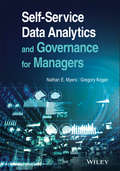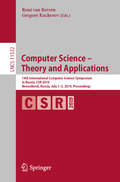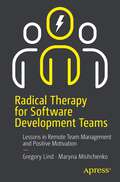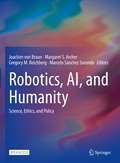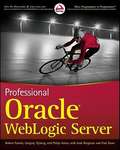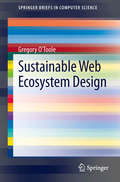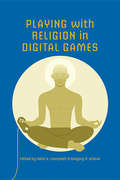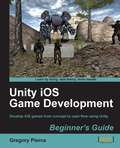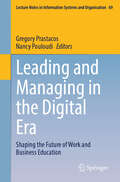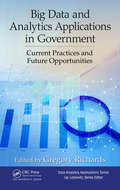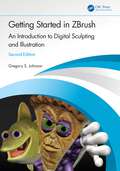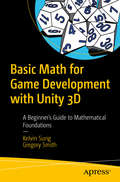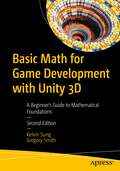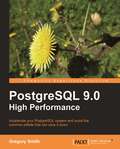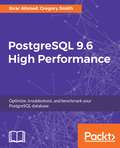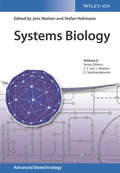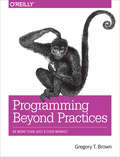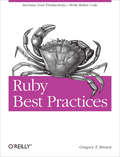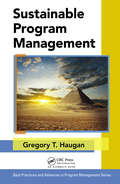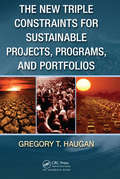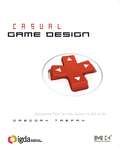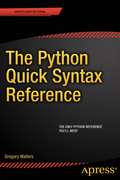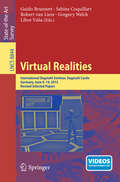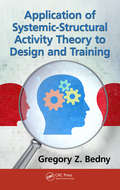- Table View
- List View
Self-Service Data Analytics and Governance for Managers
by Nathan E. Myers Gregory KoganProject governance, investment governance, and risk governance precepts are woven together in Self-Service Data Analytics and Governance for Managers, equipping managers to structure the inevitable chaos that can result as end-users take matters into their own hands Motivated by the promise of control and efficiency benefits, the widespread adoption of data analytics tools has created a new fast-moving environment of digital transformation in the finance, accounting, and operations world, where entire functions spend their days processing in spreadsheets. With the decentralization of application development as users perform their own analysis on data sets and automate spreadsheet processing without the involvement of IT, governance must be revisited to maintain process control in the new environment. In this book, emergent technologies that have given rise to data analytics and which form the evolving backdrop for digital transformation are introduced and explained, and prominent data analytics tools and capabilities will be demonstrated based on real world scenarios. The authors will provide a much-needed process discovery methodology describing how to survey the processing landscape to identify opportunities to deploy these capabilities. Perhaps most importantly, the authors will digest the mature existing data governance, IT governance, and model governance frameworks, but demonstrate that they do not comprehensively cover the full suite of data analytics builds, leaving a considerable governance gap. This book is meant to fill the gap and provide the reader with a fit-for-purpose and actionable governance framework to protect the value created by analytics deployment at scale. Project governance, investment governance, and risk governance precepts will be woven together to equip managers to structure the inevitable chaos that can result as end-users take matters into their own hands.
Computer Science – Theory and Applications: 14th International Computer Science Symposium in Russia, CSR 2019, Novosibirsk, Russia, July 1–5, 2019, Proceedings (Lecture Notes in Computer Science #11532)
by René Van Bevern Gregory KucherovThis book constitutes the proceedings of the 14th International Computer Science Symposium in Russia, CSR 2019, held in Novosibirsk, Russia, in July 2019. The 31 full papers were carefully reviewed and selected from 71 submissions. The papers cover a wide range of topics such as algorithms and data structures; computational complexity; randomness in computing; approximation algorithms; combinatorial optimization; constraint satisfaction; computational geometry; formal languages and automata; codes and cryptography; combinatorics in computer science; applications of logic to computer science; proof complexity; fundamentals of machine learning; and theoretical aspects of big data.
Radical Therapy for Software Development Teams: Lessons in Remote Team Management and Positive Motivation
by Gregory Lind Maryna MishchenkoBuild and maintain effective, collaborative, and motivated software development teams. This book addresses the challenges in doing so, like communication gaps, trust issues, and motivation problems, and provides strategies to overcome them. You'll be introduced to the Radical Therapy Dev philosophy, a holistic approach designed to optimize software development teams for better performance and overall well-being. This book highlights common pain points in software development and offers solutions to resolving much of the issues in teams. It offers strategies for implementation, focusing on adaptability and accountability, while also promoting community-supported standards. And, the book reveals why an emphasis on fostering a growth mindset, mentorship programs, and junior-intern initiatives promotes continuous learning and collaboration.With the rise of remote work, you'll see why hiring globally while thinking locally is gaining popularity. You'll also gain insights into removing barriers to remote work, along with tools and policies for remote collaboration. Additionally, the book explores the concept of cloud-native software development and its benefits. Radical Therapy for Software Development Teams critiques the traditional "agile" methodology, identifying its shortcomings while extracting valuable lessons that can still be applied effectively. What You Will LearnAddress communication gaps, foster trust, and nurture a growth mindset among team membersAvoid common feedback mistakes, recognize accomplishments, and implement a reward systemImprove software development practices and team dynamics Take a scientific approach to project management rather than traditional requirements gatheringBreak Down Communication BarriersWho This Book is ForSoftware development professionals
Robotics, AI, and Humanity: Science, Ethics, and Policy
by Margaret S. Archer Gregory M. Reichberg Joachim Von Braun Marcelo Sánchez SorondoThis open access book examines recent advances in how artificial intelligence (AI) and robotics have elicited widespread debate over their benefits and drawbacks for humanity. The emergent technologies have for instance implications within medicine and health care, employment, transport, manufacturing, agriculture, and armed conflict. While there has been considerable attention devoted to robotics/AI applications in each of these domains, a fuller picture of their connections and the possible consequences for our shared humanity seems needed. This volume covers multidisciplinary research, examines current research frontiers in AI/robotics and likely impacts on societal well-being, human – robot relationships, as well as the opportunities and risks for sustainable development and peace. The attendant ethical and religious dimensions of these technologies are addressed and implications for regulatory policies on the use and future development of AI/robotics technologies are elaborated.
Professional Oracle WebLogic Server
by Robert Patrick Gregory Nyberg Philip Aston Josh Bregman Paul DoneAuthoritative guide to Oracle WebLogic Server-from Oracle insiders If you're an experienced Java developer who wants to expand your skills, Professional Oracle WebLogic Server is the perfect guide for you. This book is written by a top-notch author team that that includes one of the lead architects from Oracle's Fusion Middleware Development Architects team. Follow their best practices, workarounds, and sound techniques and confidently develop even the most mission-critical applications with WebLogic Server. This book fully covers WebLogic Server 11g, including the new features of both JEE 5 and WebLogic Server, as well as JEE 5 annotations, Spring, JPA, JAX-WS, JMS Store-And-Forward, SAML support, and the WLST administrative scripting tool. This book is the authoritative guide to Choosing a Web application architecture Best practices for development and production environments Designing an Java EE application Building Enterprise JavaBeans in WebLogic Server Building an EJB application Packaging and deploying WebLogic web applications Developing and deploying web services Using WebLogic JMS Using WebLogic security Administering and deploying applications in WebLogic Server Optimizing WebLogic Server performance
Sustainable Web Ecosystem Design
by Gregory O'TooleThis book is about the process of creating web-based systems (i.e., websites, content, etc.) that consider each of the parts, the modules, the organisms - binary or otherwise - that make up a balanced, sustainable web ecosystem. In the current media-rich environment, a website is more than a collection of relative html documents of text and images on a static desktop computer monitor. There is now an unlimited combination of screens, devices, platforms, browsers, locations, versions, users, and exabytes of data with which to interact. Written in a highly approachable, practical style, this book is useful for stakeholders, system administrators, developers, designers, content managers, and the anonymous web user in industry, as well as faculty, staff, and students of all levels involved in teaching and learning in information technology.
Playing with Religion in Digital Games
by Heidi A. Campbell Gregory P. GrieveShaman, paragon, God-mode: modern video games are heavily coded with religious undertones. From the Shinto-inspired Japanese video game Okami to the internationally popular The Legend of Zelda and Halo, many video games rely on religious themes and symbols to drive the narrative and frame the storyline. Playing with Religion in Digital Games explores the increasingly complex relationship between gaming and global religious practices. For example, how does religion help organize the communities in MMORPGs such as World of Warcraft? What role has censorship played in localizing games like Actraiser in the western world? How do evangelical Christians react to violence, gore, and sexuality in some of the most popular games such as Mass Effect or Grand Theft Auto? With contributions by scholars and gamers from all over the world, this collection offers a unique perspective to the intersections of religion and the virtual world.
Unity iOS Game Development Beginners Guide
by Gregory PierceThis step-by-step book guides you through the process of using Unity to create monetized iOS games. It will get you through all the major learning points in a smooth, logical order. Youwill also learn how to avoid some common pitfalls. This book is for developers and designers who want to learn the process of building commercial game applications using Unity. It is intended for novices through to intermediate developers of all types regardless of their skill level with Unity. This book is packed with clear instructions and careful explanations for creating a powerful social networking site using Drupal 7. With each chapter, you add new features and content until your social network is ready to be released to the Internet where it can grow. By the end of this book, you will have a powerful social network which you can either choose to model on the case-study, or create to your own unique design. This book is aimed at anyone looking to create their own social networking website, including: Businesses - building a social network around a product or service can improve your company profile and increase customer loyalty, while an internal social network gives you employees a place to keep resources, discuss ideas, raise concerns, and keep up to date on company policies. Hobbyists - create a community around your hobbies and interests; create a local or distributed user group. Organizations and charities - raise your profile, promote your events, services, and fundraisers, and get help from the community in organizing them. Families - for large families based across the country or across the globe, keep up to date with everyone, and let everyone know what you are up to. You don't need any experience of Drupal or PHP to use this book. If you are a Drupal user you will find this book a great way to rapidly tailor an existing installation into a socially orientated website.
Leading and Managing in the Digital Era: Shaping the Future of Work and Business Education (Lecture Notes in Information Systems and Organisation #69)
by Nancy Pouloudi Gregory PrastacosRapidly emerging digital technologies such as artificial intelligence, robotics, the Internet of Things, blockchain, and virtual and augmented reality are driving profound changes in the workplace and society. These technologies are radically transforming areas of cognitive and physical work while opening up new opportunities for complex decision-making and increased efficiency. As a result, a new set of skills and a new style of leadership is required, where digital savviness is essential, together with an increased focus on collaboration, transparency, entrepreneurship, diversity, and inclusion. This book, organized in six parts, presents key developments of the digital age in leadership, management, the future of work, and business education. Part I, Governance in the Digital Era, sets the scene by reviewing the challenges that the digital era presents for policy makers at national and global levels. This research is complemented by research at the organizational level in Part II, Strategy and Entrepreneurship in the Digital Era, that discusses strategic issues that organizations of different sizes and levels of digital maturity face. Part III, Innovation and digital transformation, presents examples from different sectors, where AI and other innovative technologies are integrated in business. Part IV, The Future of Work, focuses on the changing conditions of workspaces and their implications for human resource management and the future of work. Part V, Leadership and Skills for the Digital Era, explores the impact of this changing business and societal landscape and studies the leadership style and skills needed in these conditions. Finally, Part VI, The Future of Business Education, studies how such skills and leadership may be cultivated in business education and draws lessons for the future. The book is based on a selection of the best papers on this topic presented at the international conference LMDE held in Athens, Greece, in June 2023.
Big Data and Analytics Applications in Government: Current Practices and Future Opportunities (Data Analytics Applications)
by Gregory RichardsWithin this context, big data analytics (BDA) can be an important tool given that many analytic techniques within the big data world have been created specifically to deal with complexity and rapidly changing conditions. The important task for public sector organizations is to liberate analytics from narrow scientific silos and expand it across internally to reap maximum benefit across their portfolios of programs. This book highlights contextual factors important to better situating the use of BDA within government organizations and demonstrates the wide range of applications of different BDA techniques. It emphasizes the importance of leadership and organizational practices that can improve performance. It explains that BDA initiatives should not be bolted on but should be integrated into the organization’s performance management processes. Equally important, the book includes chapters that demonstrate the diversity of factors that need to be managed to launch and sustain BDA initiatives in public sector organizations.
Getting Started in ZBrush: An Introduction to Digital Sculpting and Illustration
by Gregory S. JohnsonGetting Started in ZBrush is a gentle introduction to ZBrush, today’s premier digital sculpting program. Beginning with the fundamentals of digital sculpting as well as a thorough introduction to the user interface, Getting Started in ZBrush will have you creating a variety of professional‑level 3D models in no time. More than just another button‑pushing manual, this comprehensive guide is packed with start‑to‑finish projects that ease you into the workflow of the program, while at the same time providing tips and tricks that will allow you to achieve certain tasks much more quickly. After progressing through the tutorials, you will be shown how to customize brushes, materials, scripts, and the interface so that you can utilize these tools to their full advantage.Special consideration is given to ZBrush’s integration plug‑ins with Maya and 3ds Max, allowing you to properly import and export your models in all programs. Texturing, painting, mapping, decimation, baking, and topology are also fully covered, so your Zbrush creations can come to life without sacrificing that high‑resolution look. Ease your way into this complex subject with this straight‑forward approach to Zbrush Perfect your technique with step‑by‑step tutorials that allow you to create high‑resolution models from start to finish Expand your knowledge by visiting the companion website, which features video demonstrations, project files, texture and model files, scripts, customized menus, brushes, and additional resources Written with the digital beginner in mind, this book will teach you all of the necessary information to begin working in ZBrush to create magnificent works of digital artwork! Through this book, ZBrush will empower you to be the digital artist you always wanted to be.
Basic Math for Game Development with Unity 3D: A Beginner's Guide to Mathematical Foundations
by Gregory Smith Kelvin SungUse Unity-based examples to understand fundamental mathematical concepts and see how they are applied when building modern video game functionality. You will gain the theoretical foundation you need, and you will know how to examine and modify an implementation. This book covers points in a 3D Cartesian coordinate system, and then discusses vectors and the details of dot and cross products. Basic mathematical foundations are illustrated through Unity-based example implementations. Also provided are examples showing how the concepts are applied when implementing video game functionality, such as collision support, motion simulations, autonomous behaviors, shadow approximations, and reflection off arbitrary walls. Throughout this book, you learn and examine the concepts and their applications in a game engine. What You Will Learn Understand the basic concepts of points and vectors and their applications in game developmentApply mathematical concepts to modern video game functionality, such as spherical and box collidersImplement autonomous behaviors, including following way points, facing a target, chasing an object, etc. Who This Book is For Beginners, and those interested in the implementation of interactive games, who need a basic mathematical background or a refresher with modern examples
Basic Math for Game Development with Unity 3D: A Beginner's Guide to Mathematical Foundations
by Gregory Smith Kelvin SungThis book will teach you fundamental mathematical concepts using Unity-based custom examples, explaining the implementations and demonstrating how these concepts are applied in building modern video game functionality. You will learn the theoretical foundation of each concept, and then interact, examine, and modify the implementation to inspect the effects. Basic Math for Game Development with Unity 3D begins by explaining points in the 3D Cartesian Coordinate system. From there, you’ll gain insight into vectors and details of dot and cross products, quaternions, rotation and decomposition of vectors. These basic mathematical foundations are illustrated through Unity-based example implementations. Associated with these concept presentations are separate examples of how the concepts are applied in creating typical video game functionality, such as collision support, motion simulations, autonomous behaviors, shadow approximations, and reflections off surfaces with arbitrary orientations. After completing this book, you will have a thorough understanding of core mathematical concepts and how they are used to create compelling gameplay. What You Will Learn Understand the basic concepts of points and vectors, and their applications in game developmentGrasp the details of autonomous behaviors such as facing a target, following and chasing an object, and moreApply mathematical concepts in implementing modern video game functionality such as ray casting, collision, and motion control Who Is This Book For Game enthusiasts, hobbyists, and anyone else who is interested in the implementation of interactive games but needs basic mathematical background or could just use a refresher with modern examples.
PostgreSQL 9.0 High Performance
by Gregory SmithImproving database performance requires an equal mix of understanding theoretical concepts and working through hands-on examples. You'll find both here. Many of the examples given will be immediately useful for monitoring and improving your PostgreSQL deployments, providing insight into hard-to-obtain information about your database. This book is aimed at intermediate to advanced database administrators using or planning to use PostgreSQL. Portions will also interest systems administrators looking to build or monitor a PostgreSQL installation, as well as developers interested in advanced database internals that impact application design.
PostgreSQL 9.6 High Performance
by Gregory Smith Ibrar AhmedEnhance the performance of your PostgreSQL system with this handy guide while avoiding common pitfalls that can slow it down. About This Book • Learn the right techniques to obtain optimal PostgreSQL database performance, ranging from initial design to routine maintenance • Fine tune the performance of your queries and avoid the common pitfalls that can slow your system down • Contains tips and tricks on scaling successful database installations, and ensuring a highly available PostgreSQL solution Who This Book Is For This book is for intermediate to advanced database administrators and developers who use or plan to exploit the features of PostgreSQL in the best possible manner. While administrators can benefit from the topics related to the installation, configuration, and optimization of the server, developers will learn how to write optimal queries and address performance issues in their database design. This book will also benefit the PostgreSQL internal architects in being able to monitor the performance using benchmarking tools. What You Will Learn • Learn the best practices to configure your PostgreSQL 9.6 database for optimal performance • Write optimal queries and techniques to detect performance issue in queries • Fine tune the performance of your queries using benchmarking and indexing techniques • Ensure high performance and a highly available database using the scaling and replication techniques • Discover how to make informed speed and reliability trade-offs • Handle increasing database workloads without any hassle • Use monitoring insights to continuously rework the design and configuration for best performance In Detail Database administrators and developers spend years learning techniques to configure their PostgreSQL database servers for optimal performance, mostly when they encounter performance issues. Scalability and high availability of the database solution is equally important these days. This book will show you how to configure new database installations and optimize existing database server installations using PostgreSQL 9.6. You will start with the basic concepts of database performance, because all successful database applications are destined to eventually run into issues when scaling up their performance. You will not only learn to optimize your database and queries for optimal performance, but also detect the real performance bottlenecks using PostgreSQL tools and some external tools. Next, you will learn how to benchmark your hardware and tune your operating system. Optimize your queries against the database with the help of right indexes, and monitor every layer, ranging from hardware to queries. Moving on, you will see how connection pooling, caching, partitioning, and replication will help you handle increasing database workloads. Achieving high database performance is not easy, but you can learn it by using the right guide—PostgreSQL 9.6 High Performance. Style and approach This book has been organized in such a manner that will help you understand basic PostgreSQL 9.6 performance tuning to advanced-level configuration. There are many real-world problems explained in this book and explained in clear language, because improving database performance requires an equal mix of understanding theoretical concepts and working through hands-on examples.
Systems Biology
by Jens Nielsen Gregory Stephanopoulos Sang Yup Lee J. Nielsen Stefan HohmannComprehensive coverage of the many different aspects of systems biology, resulting in an excellent overview of the experimental and computational approaches currently in use to study biological systems. Each chapter represents a valuable introduction to one specific branch of systems biology, while also including the current state of the art and pointers to future directions. Following different methods for the integrative analysis of omics data, the book goes on to describe techniques that allow for the direct quantification of carbon fluxes in large metabolic networks, including the use of 13C labelled substrates and genome-scale metabolic models. The latter is explained on the basis of the model organism Escherichia coli as well as the human metabolism. Subsequently, the authors deal with the application of such techniques to human health and cell factory engineering, with a focus on recent progress in building genome-scale models and regulatory networks. They highlight the importance of such information for specific biological processes, including the ageing of cells, the immune system and organogenesis. The book concludes with a summary of recent advances in genome editing, which have allowed for precise genetic modifications, even with the dynamic control of gene expression. This is part of the Advances Biotechnology series, covering all pertinent aspects of the field with each volume prepared by eminent scientists who are experts on the topic in question.
Programming Beyond Practices: Be More Than Just a Code Monkey
by Gregory T BrownWriting code is the easy part of your work as a software developer. This practical book lets you explore the other 90%—everything from requirements discovery and rapid prototyping to business analysis and designing for maintainability. Instead of providing neatly packaged advice from on high, author Gregory Brown presents detailed examples of the many problems developers encounter, including the thought process it takes to solve them.He does this in an unusual and entertaining fashion by making you the main character in a series of chapter-length stories. As these stories progress, the examples become more complex, and your responsibilities increase. Together, these stories take you on a journey that will make you question and refine the way you think about, and work on, software projects.Steps in this unique journey include:Using prototypes to explore project ideasSpotting hidden dependencies in incremental changesIdentifying the pain points of service integrationsDeveloping a rigorous approach towards problem-solvingDesigning software from the bottom upData modeling in an imperfect worldGradual process improvement as an antidote for over-commitmentThe future of software development
Ruby Best Practices: Increase Your Productivity - Write Better Code
by Gregory T BrownHow do you write truly elegant code with Ruby? Ruby Best Practices is for programmers who want to use Ruby as experienced Rubyists do. Written by the developer of the Ruby project Prawn, this concise book explains how to design beautiful APIs and domain-specific languages with Ruby, as well as how to work with functional programming ideas and techniques that can simplify your code and make you more productive. You'll learn how to write code that's readable, expressive, and much more. Ruby Best Practices will help you:Understand the secret powers unlocked by Ruby's code blocksLearn how to bend Ruby code without breaking it, such as mixing in modules on the flyDiscover the ins and outs of testing and debugging, and how to design for testabilityLearn to write faster code by keeping things simpleDevelop strategies for text processing and file management, including regular expressionsUnderstand how and why things can go wrongReduce cultural barriers by leveraging Ruby's multilingual capabilitiesThis book also offers you comprehensive chapters on driving code through tests, designing APIs, and project maintenance. Learn how to make the most of this rich, beautiful language with Ruby Best Practices.
Sustainable Program Management (Best Practices in Portfolio, Program, and Project Management)
by Gregory T HauganThe world is undergoing major transitions due to changes in three driving forces-population, climate, and energy resources-making it essential for us to achieve sustainability in the implementation of projects and programs as well as our everyday life. This book provides essential information on the three major driving forces of the coming decades and presents options to assist us in moving toward a sustainable future. It uses a format that makes it easy to understand and apply to medium and long-range planning.
The New Triple Constraints for Sustainable Projects, Programs, and Portfolios
by Gregory T. HauganThe ongoing changes in population, climate, and the availability of energy have resulted in unprecedented threats and opportunities that all project and program managers, portfolio managers, and public planners need to be aware of. The New Triple Constraints for Sustainable Projects, Programs, and Portfolios offers a clear look at how these constra
RESI Basic Skills & Knowledge Lab Guide
by Stuart Palmer Whitney Freeman Gregory Ter-Oganov Joseph A. ConeyThe RESI Basic Lab Guide provides an excellent hands-on component to emphasize the theoretical materials provided in the RESI Basic Concepts and Practices Training Guide. Applying chapter concepts developed in the textbook to these lab exercises is crucial in preparing for a successful career as a computer technician.
Casual Game Design: Designing Play for the Gamer in ALL of Us
by Gregory TrefryFrom Windows Solitaire to Bejeweled to Wii Tennis, casual games have radically changed the landscape of games. By simplifying gameplay and providing quick but intense blasts of engaging play, casual games have drawn in huge new audiences of players. To entertain and engage the casual player, game designers must learn to think about what makes casua
The Python Quick Syntax Reference
by Gregory WaltersThe Python Quick Syntax Reference is the "go to" book that contains an easy to read and useguide to Python programming and development. This condensed code and syntaxreference presents the Python language in a well-organized format designed tobe used time and again. You won't find jargon, bloated samples, case studies, or history of Hello Worldand computer theory in this handy reference. This Python syntax reference ispacked with useful information and is a must-have for any Python developer. What you'll learn Variables, strings, lists, dictionaries andconditional statements are and how to use them Some of the standard libraries and what they cando to help you How to write your own functions How to write your first Python program based onterminal Input and Output How to use the Python Interactive Shell How to use classes in your Python programs Who this book is for The Python Quick Syntax Reference is a great pocket reference guide for anyone wanting to program in Python, from the new user to the experienced programmer. Table of Contents Chapter 1: Hello Python Chapter 2: Variables Chapter 3: Operators Chapter 4: Strings Chapter 5: Conditional Statements and Loops Chapter 6: Data Structures Chapter 7: Keywords Chapter 8: Functions Chapter 9: Libraries Chapter 10: Classes
Virtual Realities
by Robert Van Liere Guido Brunnett Sabine Coquillart Gregory Welch Libor VášaVirtual reality (VR) is a multidisciplinary area of research aimed at interactive human-computer-mediated simulations of artificial environments. An important aspect of VR-based systems is the stimulation of the human senses - usually sight, sound, and touch - in such a way that a user feels a sense of presence in the virtual environment. Sometimes it is important to combine real and virtual objects in the same real or virtual environment. This approach is often referred to as augmented reality (AR), when virtual objects are integrated into a real environment. Typical VR applications include simulation, training, scientific visualization, and entertainment, whereas typical AR applications include computer-aided manufacturing or maintenance and computer-aided surgery or medicine. This book comprises a collection of research and position papers presented at Dagstuhl Seminar 13241 on Virtual Realities, held at Schloss Dagstuhl, Germany, in June 2013. The 13 papers in this volume were carefully reviewed and selected from 18 submissions. They are organized in topical sections on: VR environments; interactions and user experience; virtual humans; and tele-existence.
Application of Systemic-Structural Activity Theory to Design and Training (Ergonomics Design & Mgmt. Theory & Applications)
by Gregory Z. BednyThis book offers analytical methods for studying human work in ergonomics and psychology that are similar to ones utilized by the engineering sciences. SSAT offers not only new qualitative but also formalized and quantitative methods of analysis. This book will describe quantitative methods of task complexity and reliability assessment, application
